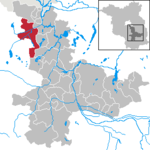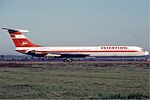Berlin Brandenburg Airport Willy Brandt (German: Flughafen Berlin Brandenburg "Willy Brandt", (IATA: BER, ICAO: EDDB), German pronunciation: [beːʔeːˈʔɛɐ̯] (listen)) is an international airport in Schönefeld, just south of the German capital Berlin in the state of Brandenburg. Named after the former West Berlin mayor and West German chancellor Willy Brandt, it is located 18 kilometres (11 mi) south-east of the city centre and serves as a base for easyJet, Eurowings and Ryanair. It mostly has flights to European metropolitan and leisure destinations as well as a number of intercontinental services.
The new airport replaced Tempelhof, Schönefeld, and Tegel airports, and became the single commercial airport serving Berlin and the surrounding State of Brandenburg, an area with a combined 6 million inhabitants. With projected annual passenger numbers of around 34 million, Berlin Brandenburg Airport has become the third busiest airport in Germany surpassing Düsseldorf Airport and making it one of the fifteen busiest in Europe.
At the time of opening, the airport has a theoretical capacity of 46 million passengers per year. Terminal 1 accounts for 28 million of this, Terminal 2, which did not open until March 24, 2022 due to the pandemic, accounts for six million, and Terminal 5, the terminal buildings of the former Berlin-Schönefeld Airport, accounts for another twelve million. Expansion buildings are planned until 2035 to be able to handle 58 million passengers annually.The airport was originally planned to open in October 2011, five years after starting construction in 2006. However, the project encountered a series of successive delays due to poor construction planning, execution, management, and corruption. Berlin Brandenburg Airport finally received its operational licence in May 2020, and opened for commercial traffic on 31 October 2020, 14 years after construction started and 29 years after official planning was begun. Schönefeld's refurbished passenger facilities were incorporated as Terminal 5 on 25 October 2020 while all other airlines completed the transition from Tegel to Berlin Brandenburg Airport by 8 November 2020.











